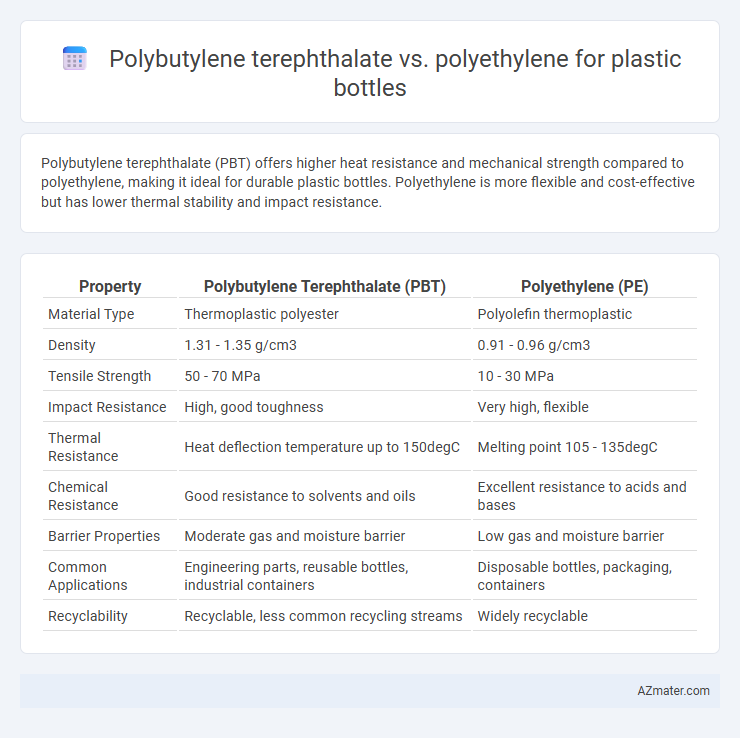Polybutylene terephthalate (PBT) offers higher heat resistance and mechanical strength compared to polyethylene, making it ideal for durable plastic bottles. Polyethylene is more flexible and cost-effective but has lower thermal stability and impact resistance.
Table of Comparison
| Property | Polybutylene Terephthalate (PBT) | Polyethylene (PE) |
|---|---|---|
| Material Type | Thermoplastic polyester | Polyolefin thermoplastic |
| Density | 1.31 - 1.35 g/cm3 | 0.91 - 0.96 g/cm3 |
| Tensile Strength | 50 - 70 MPa | 10 - 30 MPa |
| Impact Resistance | High, good toughness | Very high, flexible |
| Thermal Resistance | Heat deflection temperature up to 150degC | Melting point 105 - 135degC |
| Chemical Resistance | Good resistance to solvents and oils | Excellent resistance to acids and bases |
| Barrier Properties | Moderate gas and moisture barrier | Low gas and moisture barrier |
| Common Applications | Engineering parts, reusable bottles, industrial containers | Disposable bottles, packaging, containers |
| Recyclability | Recyclable, less common recycling streams | Widely recyclable |
Introduction to Polybutylene Terephthalate and Polyethylene
Polybutylene terephthalate (PBT) is a thermoplastic polymer known for its high mechanical strength, chemical resistance, and excellent dimensional stability, making it suitable for durable plastic bottle applications. Polyethylene (PE), particularly high-density polyethylene (HDPE), is widely used in plastic bottles due to its flexibility, impact resistance, and cost-effectiveness. While PBT offers superior heat resistance and rigidity, polyethylene excels in lightweight packaging and recyclability, influencing material selection based on bottle performance requirements.
Chemical Structure and Properties Comparison
Polybutylene terephthalate (PBT) exhibits a semi-crystalline polymer structure with repeating ester linkages derived from terephthalic acid and 1,4-butanediol, offering high thermal stability and mechanical strength ideal for rigid plastic bottles. Polyethylene (PE), consisting of long chains of ethylene monomers featuring simple carbon-carbon bonds, provides excellent chemical resistance and flexibility but lower thermal resistance compared to PBT. The aromatic backbone in PBT enhances dimensional stability and barrier properties, while the saturated hydrocarbon structure in polyethylene results in superior impact resistance and moisture barrier for plastic bottle applications.
Manufacturing Processes of PBT vs Polyethylene
Polybutylene terephthalate (PBT) undergoes injection molding and extrusion processes characterized by high-temperature crystallization, enhancing mechanical strength and dimensional stability for plastic bottles. Polyethylene (PE), typically processed through blow molding and extrusion blow molding, offers lower melting points, enabling faster cycle times and cost-effective mass production of lightweight bottles. Manufacturing PBT requires precise thermal control to maintain polymer properties, whereas PE's versatility supports diverse bottle shapes and wall thicknesses with simpler processing conditions.
Mechanical Strength and Durability
Polybutylene terephthalate (PBT) exhibits superior mechanical strength and durability compared to polyethylene (PE) in plastic bottle applications, offering higher tensile strength and enhanced resistance to impact and deformation. PBT's robust thermal stability and resistance to environmental stress cracking make it ideal for long-term use under varying temperature conditions. In contrast, polyethylene, while flexible and cost-effective, generally displays lower mechanical strength and is more susceptible to wear and environmental degradation over time.
Barrier Properties: Moisture and Gas Permeability
Polybutylene terephthalate (PBT) exhibits superior barrier properties compared to polyethylene (PE), significantly reducing moisture and gas permeability in plastic bottles. PBT's crystallinity and molecular structure create a dense polymer matrix that effectively limits oxygen and water vapor transmission, enhancing shelf life and product stability. In contrast, polyethylene's relatively higher permeability makes it less suitable for applications requiring stringent moisture and gas barrier performance.
Environmental Impact and Recyclability
Polybutylene terephthalate (PBT) offers higher thermal stability and is more resistant to chemical degradation compared to polyethylene, making it less prone to leaching harmful substances in plastic bottles. In terms of environmental impact, polyethylene, especially high-density polyethylene (HDPE), is more widely recycled with established processes, whereas PBT recycling is less common and requires specialized facilities. The overall recyclability of polyethylene contributes to a lower lifecycle carbon footprint, while PBT's superior durability may extend product life but complicate end-of-life processing.
Cost Analysis: PBT vs Polyethylene
Polyethylene generally offers lower production costs compared to Polybutylene terephthalate, making it a more economical choice for plastic bottles. Polybutylene terephthalate provides superior thermal and chemical resistance but at a higher raw material and processing cost. Cost analysis reveals that polyethylene's affordability and ease of molding contribute to its widespread use in bottle manufacturing, while PBT is preferred for specialized applications demanding durability and heat resistance despite its premium price.
Safety and Food Contact Compliance
Polybutylene terephthalate (PBT) offers superior chemical resistance and thermal stability compared to polyethylene (PE), making it safer for long-term food contact applications. PBT complies with stringent FDA and EU food contact regulations due to its low permeability and resistance to leaching, ensuring minimal risk of contamination. Polyethylene, while widely used for plastic bottles, may have higher migration potential for additives and generally requires careful formulation to meet the same food safety standards as PBT.
Applications in Plastic Bottle Industry
Polybutylene terephthalate (PBT) offers superior chemical resistance and thermal stability compared to polyethylene, making it ideal for durable, high-performance plastic bottles used in automotive and industrial liquid containers. Polyethylene, especially high-density polyethylene (HDPE), dominates the plastic bottle industry due to its cost-effectiveness, excellent moisture barrier properties, and ease of molding, primarily in food, beverage, and household product packaging. While PBT excels in specialized applications requiring strength and heat resistance, polyethylene remains the preferred choice for mass-produced consumer bottles thanks to its recyclability and versatility.
Future Trends and Innovations in Bottle Materials
Polybutylene terephthalate (PBT) offers superior chemical resistance and thermal stability compared to polyethylene, making it a promising material for next-generation plastic bottles requiring enhanced durability and performance. Innovations in bio-based PBT and advanced copolymer blends aim to improve recyclability and sustainability, addressing environmental concerns associated with traditional polyethylene bottles. Future trends highlight the integration of smart additives and nanotechnology in PBT formulations to deliver lightweight, strong, and multifunctional bottles for diverse beverage and pharmaceutical applications.

Infographic: Polybutylene terephthalate vs Polyethylene for Plastic bottle
 azmater.com
azmater.com